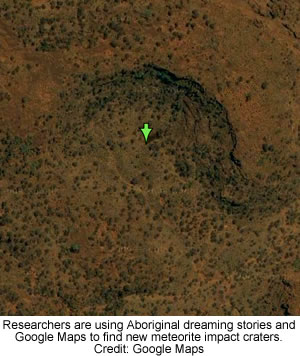 |
Canku Ota
|
 |
|
(Many Paths)
|
||
|
An Online Newsletter
Celebrating Native America
|
||
|
February 1, 2010 - Volume
8 Number 2
|
||
|
|
||
|
Aboriginal Folklore
Leads To Meteorite Crater
|
||
|
by Aaron Cook - Cosmos
Online
|
||
|
credits: {credits}
|
 SYDNEY,
NSW, AUSTRAILIA: An Australian Aboriginal dreaming story has helped
experts uncover a meteorite impact crater in the outback of the Northern
Territory. SYDNEY,
NSW, AUSTRAILIA: An Australian Aboriginal dreaming story has helped
experts uncover a meteorite impact crater in the outback of the Northern
Territory.
Duane Hamacher, an astrophysicist studying Aboriginal astronomy at Sydney's Macquarie University, used Google Maps to search for the signs of impact craters in areas related to Aboriginal stories of stars or stones hitting the ground. One story, from the folklore of the Arrernte people, is about a star falling to Earth at a site called Puka. This led to a search on Google Maps of Palm Valley, about 130 km southwest of Alice Springs. Here Hamacher discovered what looked like a crater, which he confirmed with surveys in the field in September 2009. Cosmic
impact "There is no other way to explain this than as a cosmic impact," said Hamacher. "It couldn't have been erosion and there is no volcanic activity in the area." Macquarie University co-worker, Craig O'Neill, added that a tiny amount of 'shocked quartz' had also been found at the site. "These were very rare, but only form if a rock has experienced a shock blast like that from a nuclear bomb or meteorite impact," he said. The research is described in papers Hamacher is preparing for submission to the journals Archaeoastronomy and Meteoritics and Planetary Science. Crater
spotting Another crater at Gosse's Bluff, 170 km west of Alice Springs, is 140 million years old, and is also the subject of an Arrernte dreaming story about a "cosmic baby" which fell to Earth. Instead, Hamacher thinks Arrernte Aborigines may have learned to recognise craters from more recent impacts and then deduced the origin of the Palm Valley and Gosse's Bluff craters. One more recent example of craters created by an impact are the Henbury craters, 70 km from Palm Valley and just 4,000 years old. He noted that his theory is speculation and the presence of the Palm Valley crater near to the origin of the Arrernte story could simply be a coincidence. Hamacher's comparison of known craters and Aboriginal stories about cosmic impacts have not yet uncovered conclusive evidence that meteorite impacts have been witnessed and incorporated into oral tradition. But he has found documented evidence of the Henbury craters being referred to as "chindu china waru chingi yabu" by Aboriginal elders, which he said roughly translates as "Sun walk fire devil rock". Sacred
stories Hamacher said that he thinks it is possible that a direct link will be found and that further research into dreaming stories could help uncover new meteorite impact sites. He hopes to return to the area to talk to Aboriginal elders about their stories. |
|
|
||
|
|
||
| Canku Ota is a free Newsletter celebrating Native America, its traditions and accomplishments . We do not provide subscriber or visitor names to anyone. Some articles presented in Canku Ota may contain copyright material. We have received appropriate permissions for republishing any articles. Material appearing here is distributed without profit or monetary gain to those who have expressed an interest. This is in accordance with Title 17 U.S.C. Section 107. | ||
|
Canku Ota is a copyright ©
2000, 2001, 2002, 2003, 2004, 2005, 2006, 2007, 2008, 2009, 2010
of Vicki Barry and Paul Barry.
|
||
 |
 |
|
|
The "Canku
Ota - A Newsletter Celebrating Native America" web site and
its design is the
|
||
|
Copyright ©
1999, 2000, 2001, 2002, 2003, 2004, 2005,
2006, 2007, 2008, 2009, 2010
of Paul C. Barry.
|
||
|
All Rights Reserved.
|
||